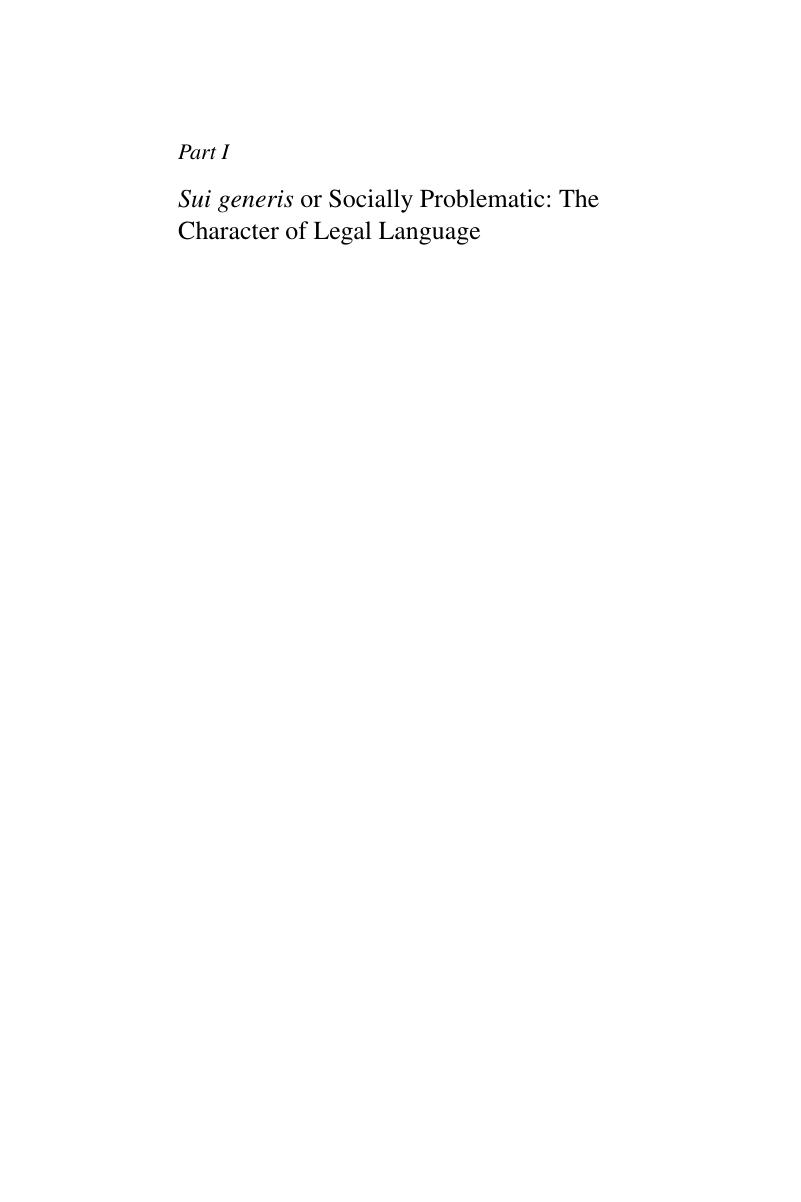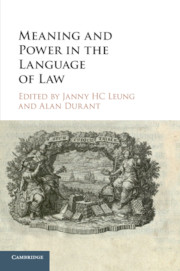Book contents
- Meaning and Power in the Language of Law
- Meaning and Power in the Language of Law
- Copyright page
- Contents
- Contributors
- Acknowledgements
- Editors' Introduction
- Part I Sui generis or Socially Problematic: The Character of Legal Language
- Part II Imperfect Fit between Legal Categories and Social Discourse
- Part III Written in Silence: Hidden Social Meanings in Legal Discourse
- Part IV Conflict between Linguistic and Legal Ideologies
- Part V Demands of Law and Limits of Language
- Afterword
- Index
- References
Part I - Sui generis or Socially Problematic: The Character of Legal Language
Published online by Cambridge University Press: 28 December 2017
- Meaning and Power in the Language of Law
- Meaning and Power in the Language of Law
- Copyright page
- Contents
- Contributors
- Acknowledgements
- Editors' Introduction
- Part I Sui generis or Socially Problematic: The Character of Legal Language
- Part II Imperfect Fit between Legal Categories and Social Discourse
- Part III Written in Silence: Hidden Social Meanings in Legal Discourse
- Part IV Conflict between Linguistic and Legal Ideologies
- Part V Demands of Law and Limits of Language
- Afterword
- Index
- References
Summary

- Type
- Chapter
- Information
- Meaning and Power in the Language of Law , pp. 17 - 92Publisher: Cambridge University PressPrint publication year: 2018
References
References
References
References
References
References
Cases Cited
Anonymous v Anonymous 67 Misc.2d 982, 325 N.Y.S.2d 499 (N.Y. Sup. Ct. 1971).
Attorney-General (Cth) v “Kevin and Jennifer” [2003] Fam CA 94.
Bellinger v Bellinger [2001] EWCA Civ 1140. 2003 WL 1610368 (2003).
Brutus v Cozens [1973] AC 854.
Corbett v Corbett [1971] 2 All ER 33.
Goodwin v United Kingdom (2002) 35 EHRR 18.
Kantaris v Kantaris 84 So. 2d 155 (2004).
Littleton v Prange 9 S.W.3d 223 (Tex. App.–San Antonio 1999).
M.T. v T.J. 40 N.J. Super. 77 (1976).
Nix v Hedden 149 U.S. 304 (1893).
R v Harris (1988) 17 NSWLR 158.
R (Quintavalle) v Secretary of State for Health [2003] 2 AC 687.
Re Kevin 165 FLR 404 (2001).
Re Ladrach 32 Ohio Misc.2d 6 (1987).
re the Estate of Marshall G. Gardiner 73 Kan. 191, 42 P.3d 120 (2002).
Secretary, Department of Social Security v State Railroad Authority (1993) 43 FCR 299.
S Y v S Y [1963] P 37, [1962] 3 WLR 526.
Talbot (otherwise Poyntz) v Talbot, John David (otherwise Talbot, Mabel) (1967) 111 S.J. 213.
W v Registrar of Marriages (CACV 266/2010).
W v The Registrar of Marriages [2013] HKCFA 39.
Anonymous v Anonymous 67 Misc.2d 982, 325 N.Y.S.2d 499 (N.Y. Sup. Ct. 1971).
Attorney-General (Cth) v “Kevin and Jennifer” [2003] Fam CA 94.
Bellinger v Bellinger [2001] EWCA Civ 1140. 2003 WL 1610368 (2003).
Brutus v Cozens [1973] AC 854.
Corbett v Corbett [1971] 2 All ER 33.
Goodwin v United Kingdom (2002) 35 EHRR 18.
Kantaris v Kantaris 84 So. 2d 155 (2004).
Littleton v Prange 9 S.W.3d 223 (Tex. App.–San Antonio 1999).
M.T. v T.J. 40 N.J. Super. 77 (1976).
Nix v Hedden 149 U.S. 304 (1893).
R v Harris (1988) 17 NSWLR 158.
R (Quintavalle) v Secretary of State for Health [2003] 2 AC 687.
Re Kevin 165 FLR 404 (2001).
Re Ladrach 32 Ohio Misc.2d 6 (1987).
re the Estate of Marshall G. Gardiner 73 Kan. 191, 42 P.3d 120 (2002).
Secretary, Department of Social Security v State Railroad Authority (1993) 43 FCR 299.
S Y v S Y [1963] P 37, [1962] 3 WLR 526.
Talbot (otherwise Poyntz) v Talbot, John David (otherwise Talbot, Mabel) (1967) 111 S.J. 213.
W v Registrar of Marriages (CACV 266/2010).
W v The Registrar of Marriages [2013] HKCFA 39.

